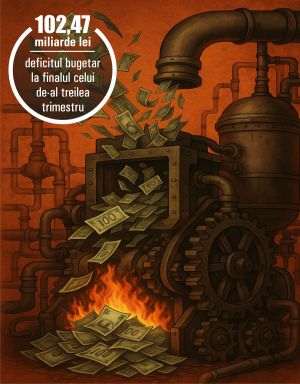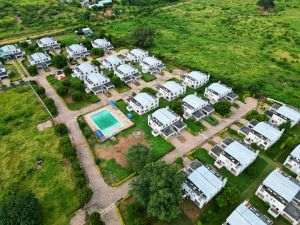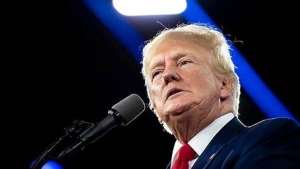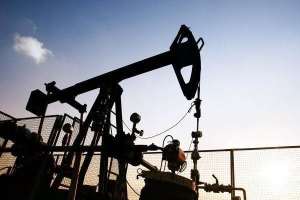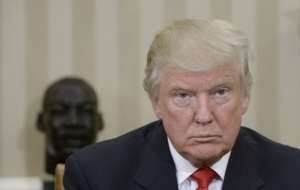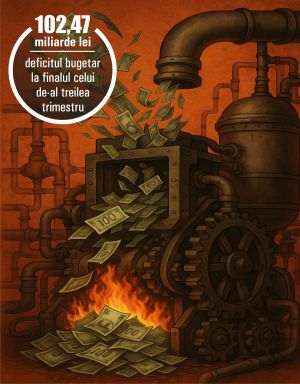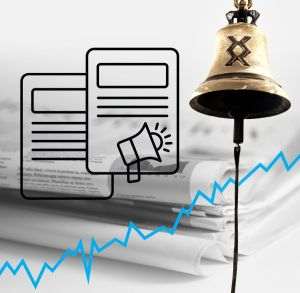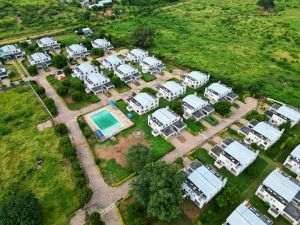UniCredit Bank analysts are issuing a warning that the Romanian government is repeating many of the mistakes that have led to the recession of 2009-2010. The quoted experts are mentioning both the fiscal policy that is risky for the economy, as well as the fact that the leu will significantly weaken in 2018, and the deficit may increase to 3.7%. Among other things, the UniCredit report issued on Friday predicts an EUR/RON exchange rate of 4.7 and a policy rate of 2.5%, for the beginning of next year.
Adrian Vasilescu, strategy consultant with the National Bank of Romania, thinks the report is "a bit too pessimistic" and says he has no faith in fortune tellers.
"We see that there are many crystal ball readers, even in the banking system, and I am referring here to the analysts in the commercial banks, who are required to put out reports and are sometimes tempted to say something shocking. I see that in their reports they claim to predict very accurately what will happen in the evolution of the EUR/RON exchange 4.6 towards the end of the year and 4.7 in the first quarter of 2018. You can't get any more specific than that. When the estimates are so accurate, you have to doubt them. When one makes a statement this accurate about the exchange rate, it is to be envied, but not to be believed".
Adrian Vasilescu further said: "The picture painted by the analysts of UniCredit is a bit too pessimistic, but I don't believe in fortune tellers, even if they are using efficient models and which can lead to interesting conclusions when combined. Over the years I have come to realize that they miss the target that they are estimating. And I will give you a concrete example - prior to the Board meeting of the NBR of October 3rd, prestigious analysts were predicting that the Central Bank would raise the policy rate. It didn't. And I can tell you why it didn't, either. The NBR believes in the key rate, in the policy rate. Long time ago, through the voice of its governor, the NBR pointed out that, unlike the central banks in developed countries - the FED and the ECB, which have lowered the interest rate too much and at important moments were left without weapons and without bullets, unable to use the monetary policy instruments -, the NBR has always taken care not to take the policy rate too low.
In 2009, it began cutting the policy rate and after it was cut several times, it stagnated. Then, in November 2011, it was the beginning of a new wave of cutting the interest rate, which went to 1.75%, when it stopped falling. In doing so, the Central Bank of Romania has kept its weapons and its bullets to use if, Heaven forbid, hard times come. Now, on October 3rd, it did the same - it has postponed raising the interest rate".
Vasilescu also said that the central banks raise the policy rate when inflation increases, "which is fought with higher interest rates": "We are coming after two years of negative inflation - 2015 and 2016. We have seen that in the beginning of this year we have escaped negative inflation and it has started rising towards 2%, but we are still far away from this threshold. We are watching several factors - there many countries in the world that publicly display the idea that an inflation rate of 2% is optimal. The ECB has been fighting for several months to raise the inflation rate to 2% and it is failing. Why would we have raised the interest rate? We also want the inflation to rise to 2% and stay there".
Aside from inflation, there a series of factors that the NBR keeps in mind in its Board meeting, when it sets the policy rate, said Adrian Vasilescu. "After all the analyses are presented, all the points of view, after the monetary policy meeting takes place as well, which precedes that of the Board, it is only in the end that the policy rate is voted for. Until then, nobody can estimate what will happen with it. First, all the factors are analyzed, several details are taken into consideration, not just the prices but also the GDP, deficit etc. and only then a decision is voted on".
• UniCredit: "The economic growth may slow down from 5.3% in 2017 to 3.6% in 2018"
The quick economic growth is being endangered by the escalation of the foreign and fiscal imbalances, UniCredit Bank economists think. The 5% growth predicted for this year hides increasingly high fiscal imbalances, the quoted analysts say: "Ad-hoc measures, tax hikes and cuts in public spending could keep the budget deficit below 3% of the GDP this year, but not in 2018. The increase in private consumption and the low inflows of European funds will lead to net outflows of capital from Romania. Moreover, the increase of the salaries at a quicker pace than that of the productivity hints that the leu should depreciate in the coming years. The NBR has raised the deposit facility interest rate by 25 basis points to 0.5% in October and we are anticipating a new increase of 25 basis points in November, and in the first half of 2018 it will decide to raise the policy rate three times".
Less than ten years after one of the harshest austerity programs in Europe, the Romanian government is repeating many of the mistakes that have led to the deep recession of 2009-2010, the quoted report claims, which mentions that the fiscal policy represents the biggest risk to the macroeconomic stability.
UniCredit Bank warns: "The government continues to implement populist measures, even though the resources are limited: we expect an increase of no more than 1.2% of tax revenues this year, despite a nominal growth of the GDP of 9.9%. Moreover, the salaries in the public sector and the social spending could increase 16.6%, in 2017 compared to 2016. In search of additional revenues, the government has become more creative, but not necessarily more efficient: 1. it has scrapped previous fiscal relaxation decisions (such as the extra fuel excise which was eliminated in January and reintroduced in September-October); 2. it has toned down certain measures it had previously announced (84% of next year's salaries in the public sector will be offset by the full shifting of the social security contributions to the employees);
3. it has transferred money from the companies owned by the state (by allocating dividends out of the profits of 2016 and the companies' reserves);
4. it has cut the public spending by the equivalent of 1.3% of the GDP compared to the initial planning;
5. it has cut the VAT reimbursements to compensate - at least temporarily - the weak collection of fiscal revenues".
UniCredit Bank analysts point out that, even though following the significant budget adjustment, the 2017 deficit may stay near or below 3% of the GDP, especially if part of the investments made this year will be classified as defense spending, still, the Government is at risk of ending 2018 with a budget deficit of approximately 3.7% of the GDP, because budget revenues can not fund the fiscal relaxation planned for next year. "This estimate of the deficit takes into account a continued reduction of public sector investments", the quoted sources warn.
The economic growth could slow down from 5.3% in 2017 to 3.6% in 2018, amid a tapering of the main growth factors, namely consumption and inventories, the analysts of the Italian bank warn.
• UniCredit estimates that we are at risk of two conflicts with the European authorities
The fast salary raise will continue to support private consumption, but net revenues will grow slower than gross salaries, according to the quoted sources. These show that public sector employees will see an increase of the gross salary of 25-70% in 2018, with the highest increases planned in education and healthcare. UniCredit says: "Even though the latter have been promised a salary increase of 148%, we nevertheless expect an increase of just 70%, because the additional budget spending up to that level would amount to 0.8% of the GDP. Moreover, the shifting of the social security contributions to the employees will keep the average growth rate of net salaries in the public sector within a range of « just » 4 - 40%. Concurrently, the net average salary in the private sector could increase 6% next year, similar to the wage increase in 2017. The matching increase of the median gross salary is 27%, if the government forces private companies to raise the employees gross salaries with the equivalent of the social security contributions that they will no longer pay. Grain inventories will increase following the high grain harvest, but the investments will be affected by the postponement of the infrastructure works and the increase of unused production capabilities in the industry (in contrast with the trend in Central Europe). Net exports will put a brake on the economic growth, because the expansion of retail trade is predominantly covered by imports. Moreover, the frequent raises of the minimum wage will continue to eat into the profit margins of Romanian exporters, which would need a weaker leu to improve their financial situation".
In the opinion of UniCredit Bank, the strong domestic and internal demand will support industrial output, even though its growth rate could slow down in 2018 amid some basic effects, of low investments, of higher salary costs and of the slow increase of the energy output. Services will continue to grow rapidly, one of the most performing sectors being international transports, IT and retail, the quoted sources show.
The UniCredit report further points out: "We estimate a two figure increase of constructions in the private sector across all their subcomponents: retail spaces, logistics, residential and industrial output. The net capital flows could be negative this year and next year, in stark contrast with regional trends. We are anticipating an increase in the goods trade deficit to more than 8% of the GDP, leading to a deepening of the current account deficit, despite stronger exports of services. Foreign Direct Investments could mostly consist of reinvested profits, keeping their weight in the GDP unchanged. What is more worrisome is the fact that the government has dropped improving the absorption of European grants this year, dropping the planned co-financing. The inflows of structural and cohesion funds have dropped to 274 million Euros in the first seven months of 2017 (according to the Ministry of Finance) and may be less than 1% of the GDP this year. Next year's improvement could be minor, keeping into account the hike of the budget constraints, a context in which it is unlikely new major infrastructure projects would be launched".
The leu is still overvalued due to the dropping capital inflows and the hike of the labor workforce cost, specialists warn, and they say that the depreciation trend that is specific to autumn months, together with the fiscal and political risks could keep the EUR-RON exchange rate near or even above 4.60, until the end of the year: "In our opinion the NBR will allow a gradual depreciation of the leu, and the transition towards the 4.60-4.70 range will happen in the first quarter of 2018, coinciding with the beginning of the policy rate hike cycle.
The NBR began the monetary tightening by raising the deposit facility rate by 25 basis points to 0.5% in October and we anticipate a new hike to 0.75% in November 2017. Until then, the annual inflation could exceed 2% due to the reintroduction of the fuel excise and the rise in the price of electricity and natural gas, all reflected in the prices paid by consumers. The total and basic inflation could exceed the target of the NBR in January 2018, due to the unfavorable effects and the increase in the prices of non-food products and services. The NBR could react by hiking the policy rate three times, to the level of 2.5% between February and May 2018".
UniCredit estimates that there is a risk of two conflicts with the European authorities, one tied to fiscal sustainability and the second tied to the independence of justice: "The European Commission has more tools to punish Romania than it does Poland and Hungary, in the context of the existence of the Cooperation and Verification Mechanism for judicial reforms".
UniCredit predicts a budget deficit of approximately 3.7% of the GDP for next year.
Vasilescu, BNR: "The picture painted by the analysts of UniCredit is a bit too pessimistic, but I don't believe in fortune tellers, such accuracy is to be envied, but not to be believed".
UniCredit: "Fiscal policy - the biggest risk to the macroeconomic stability".

